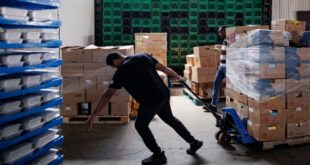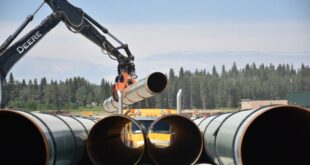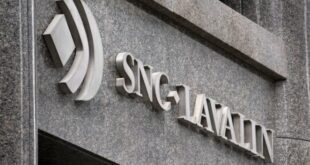‘Indigenomics’ event held to bring companies and governments into wave of growth
Entrepreneur Rob Tebb can see his company becoming bigger — a lot bigger.
"The opportunity is there to just grow this business to four or five times the size that it is," he said.
Tebb, who is Métis, owns Regina-based Xtended Hydraulics & Machine with his wife, Katherine. More than half their staff of 26 is Indigenous.
The high-tech company makes specialized parts, mostly for mining companies, and has just broken into a new market: the defence industry. It's a moment Tebb has been working toward for years.
Like many Indigenous business leaders, Tebb said he feels a wave of economic development and business opportunity is rolling across the country.
This week, that wave officially surged into Toronto at a conference called Indigenomics on Bay Street, which brought together a mix of government, corporate and Indigenous leaders.
All were focused on growing the Indigenous economy in Canada to $100 billion a year and marking the paths to make the goal a reality.
Carol Anne Hilton, the event's organizer and founder of the Indigenomics Institute, said putting Bay Street into the conference name is an "invitation for corporate Canada to respond" and to learn "about the strategic advantage of working with Indigenous people."

This Indigenous-owned business sees 'huge' opportunity ahead
2 hours ago
Featured VideoRob Tebb, co-owner of Regina-based Xtended Hydraulics & Machine, says about half his current team members are Indigenous — and he sees more opportunities for growth and training ahead.
What is 'Indigenomics'?
"Indigenomics" is "economics from an Indigenous worldview," Hilton said, adding that she invented the word before writing a book on the subject.
It's about taking a "constructive, generative" approach to economic growth for Indigenous communities, she said, in order to establish "the systemic inclusion of Indigenous Peoples in today's modern economy."
Hilton, a member of Hesquiaht First Nation in British Columbia, said she believes it's an antidote to the historical injustice of their exclusion from the economy through discrimination, laws like the Indian Act and Canada's system of reserves.
Indigenomics on Bay Street is the ninth Indigenous business event she's organized since 2019, but it's her first in the country's financial capital.
The $100-billion question
The Indigenous contribution to Canada's economy is on an upward trend, with the latest data putting the value at almost $50 billion in 2020.
So where does the $100 billion goal come from?
First, Hilton said, it's based on Canada's gross domestic product — which according to Statistics Canada was about $1.98 trillion in 2021 — and the fact that Indigenous people make up five per cent of the population.
"If we look at Indigenous Peoples as being generative of five per cent of Canada's economic activity, that is looking directly at $100 billion," she said.
But the number is also aspirational to provide Indigenous people with a "marker," Hilton said, because "we need something to kind of propel us out of the status quo."
So how quickly can the Indigenous economy grow from its current $50 billion to $100 billion?
Hilton and others believe the goal will be met within a few years.
At the conference in Toronto, panel discussions were organized around opportunities and strategies to drive economic growth, generate wealth and supply jobs.
Sessions on major infrastructure builds, clean energy projects, raising capital and procurement policies to support Indigenous suppliers were some of the key topics.
The power of procurement policies
In recent years, governments and companies have enacted supplier diversity policies, using their purchasing power as a tool for equity by creating business opportunities for minority groups to sell them goods and services.
The federal government requires all departments and agencies to "ensure a minimum of 5% of the total value of contracts are held by Indigenous businesses."
Tabatha Bull, CEO of the Canadian Council for Aboriginal Business (CCAB), said she believes procurement is a key part of hitting the $100-billion target. She led a procurement panel at the conference.
"If you think about the government, who spends around $20 billion annually, a five per cent commitment is a significant injection into the Indigenous economy," Bull told CBC News.
Since 2018, the CCAB has run a program called Supply Change to help companies and organizations connect with Indigenous suppliers — and almost 150 companies have signed on.
Indigenous young people are a fast-growing demographic, Bull said, and First Nations entrepreneurs launch startups "at nine times the rate of non-Indigenous businesses."
Bull, a member of Ontario's Nipissing First Nation, said procurement policies that support Indigenous entrepreneurs help the broader economy.
Back in Regina, Rob Tebb said some companies' Indigenous procurement policies don't actually work as intended, but those developed in collaboration with Indigenous communities can make a big difference.
The CCAB introduced Tebb's manufacturing business to its first defence industry client. Thanks to that defence company's Indigenous procurement program, Tebb is making parts for a military vehicle.
He said he's optimistic that more military jobs will come. "Once you get work from one defence company, now all the other ones see you as a qualified vendor," he said.
Learning from First Nations in the U.S.
Bill Lomax, CEO of the First Nations Bank of Canada (FNBC), was another speaker at the conference in Toronto.
Lomax, who took the bank's top job this past spring, has more than 20 years' experience in U.S. banking and finance, an MBA and a law degree.
A member of the Gitxsan Nation in northwestern B.C., Lomax is among those who believes the Indigenous economy in Canada will reach $100 billion soon.
"It wouldn't take that long for us to double or triple," he said.
In the United States, Lomax said, there are 30 to 40 First Nations with multibillion-dollar economies — and many others with economies that tally in the hundreds of millions of dollars. Over eight years with Goldman Sachs, he worked with American tribal nations managing a portfolio worth more than $2 billion.
His conference keynote address focused on a few lessons that First Nations in Canada can take from the success of some Indigenous communities south of the border.
Like the CCAB's Bull, Lomax said he also believes procurement policies are an important driver of economic growth, but he said Indigenous communities in Canada should lean on the federal government to expand its spending to be on par with Indigenous procurement in the U.S.
Lomax also recommended that First Nations work to get into the gaming industry. In the U.S., gaming brought $41 billion to Indigenous communities last year, while casinos in Las Vegas took in only $8.3 billion, he said.
First Nations in Canada should also focus on the cannabis industry, he said, adding that increasing participation in natural resources projects, as well as the development of real estate and businesses on urban reserves, will drive growth.
The FNBC has expansion plans to support more communities and manage investments, and Lomax said he's confident that "we're going to see a lot of First Nations become economic powerhouses."
The rising tide
André Le Dressay, director of the Tulo Centre of Indigenous Economics at Thompson Rivers University in Kamloops, B.C., has worked with Indigenous communities and institutions on economic development for 30 years.
He told CBC News that "the potential of the Indigenous economy has certainly been undervalued" and that it's "to the shame of Canada" that Indigenous people haven't been engaged as full partners in the economy.
Tebb, co-owner of Xtended Hydraulics & Machine in Regina, said he can see this changing, and he imagines doubling his staff to fill new orders at his shop.

"When I look back at the past, I see indigenous people left out of the economic fabric of our country, and now I see excitement and opportunities that I've never seen before," he said.
"You can see it in the communities. There's hope for a future."
Carol Anne Hilton agrees. "I feel very much that this is a powerful time to be alive," she said, "where Indigenous people are picking up business as a tool and using it as a stake in the ground to say we're still here."
A rising economic tide in Indigenous communities, she said, is good for the economy as a whole.
*****
Credit belongs to : www.cbc.ca
 MaharlikaNews | Canada Leading Online Filipino Newspaper Portal The No. 1 most engaged information website for Filipino – Canadian in Canada. MaharlikaNews.com received almost a quarter a million visitors in 2020.
MaharlikaNews | Canada Leading Online Filipino Newspaper Portal The No. 1 most engaged information website for Filipino – Canadian in Canada. MaharlikaNews.com received almost a quarter a million visitors in 2020.







